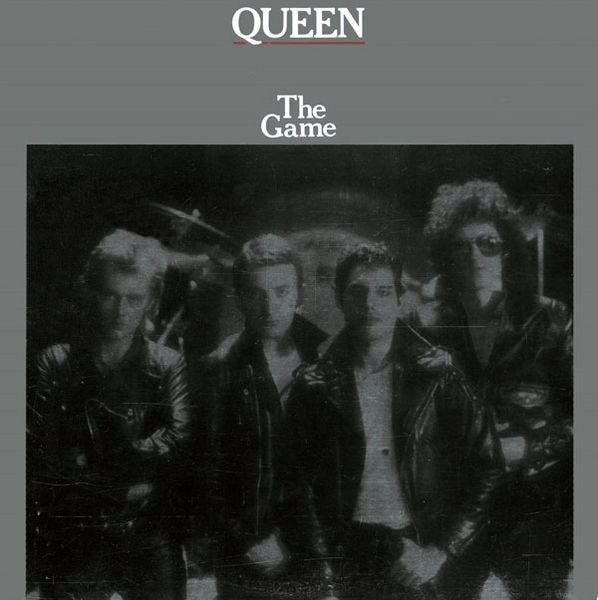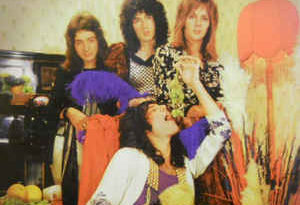03-XX-1975 – Sheer Heart Attack – Circus
From a sinister moan, like a furious fiend lurking in a deep cave, Brian May’s fed-back power chords slid up to a piercing demonic howl. With three giant strides, Freddie Mercury emerged out of the darkness and with a sweeping display of white pleated satin, he raised proudly an arm gleaming with silver jewellery beneath the intense spotlight. Roger Taylor’s drums rolled like storm clouds over John Deacon’s pulsating bass, signalling the commencement of Queen’s “Ogre Battle.” Then, stopping Roger’s thundering tom-toms dead in their onslaught, Freddie smiled at the hysterical front rows of the packed English audience, and asked rhetorically, “How do you like the show so far?”
The self-assured and sensual vocalist already knew the answer to his own sly question. Within mere weeks of its release, Queen’s third album, Sheer Heart Attack (on Electra), rose to a regal dominance on the British charts. “Killer Queen,” a delightful little ditty straight from Albion’s gas lit dance halls, became Queen’s first Number One single. Although no fewer than twenty bands brought modern times rock ‘n roll to England’s farthest reaches last winter, only Queen’s tour had inspired total sell-outs of every concert hall they played. The theatrical band with musical muscle had retained their intellectual following at the universities, while their legion of fans among Britain’s younger ravers was snowballing like an unstoppable pop juggernaut.
But America remained to be conquered. Certainly Brian May’s untimely bout with hepatitis during their fateful first tour had prompted sympathetic support and positive publicity for Queen in this country. Queen II had sold surprisingly well, even without the added promotional punch the tour would have provided. Now Queen, again intact and more full of impact than ever, were determined to pick up where they had reluctantly left off a year before. A new album, a new show, new costumes, lights, and sound, were all designed to allow an invasion of the States to follow smoothly their most successful European tour to date.
Queen to Led Zep One: On the eve of their second American expedition, Freddie Mercury’s hopes ran higher than ever before. “A lot of things in Queen just seem to fall into place,” he predicted optimistically. So confident was Fred that he could remark without hesitation, “The whole situation is an exact replica of Led Zeppelin back in 1969.” And the United States was the only missing link. Their tour of the European continent late in 1974 had all but incited riots, while in Japan, the world’s second largest music market, Queen had miraculously become the most popular hard rock group. Even Jethro Tull, Yes, and Emerson, Lake and Palmer had given way to Queen’s majesty. Queen’s American manager, Jack Nelson, was himself amazed: “They’re getting even bigger than Deep Purple there, and they used to own Japan.”
Although Deep Purple in particular have become notorious for recurring personnel changes provoked by Ritchie Blackmore’s resolute moodiness, Queen are a group in the truest sense. not that Queen’s rock comes together as sweetly and smoothly as whipped cream, but constructive controversy does bring out the best in four superb musicians, each indispensable to the Queen sound and style. “We have the most outrageous rows,” which Mercury readily admitted to an English writer. “There are so many things we don’t see eye to eye about in the group, even as to the titles of our albums. We row about everything, even about the air we breathe. But I think that’s good, because we get the cream of the crop. It’s good, that’s healthy.”
Mercury does indeed speak for the rest of Queen when he insists, “I don’t like compromises – everything has to be done to perfection. I have always put everything into things that interest me, so I put everything into my music.” The key to the solidly four-square Queen cartel is an intensity, professionalism, and dedication built in to the band’s four distinct personalities. Fred’s conscious that the glare of public attention is usually focused on himself. “I know the others have been feeling a little neglected,” he confided to a close friend. “I’m trying very hard to persuade people that I’m not the leader of the group, that there’s no such thing, but it’s not easy.” Outside looking in: The amazing diversity of material on Sheer Heart Attack, with striking contributions from all four Queens, should go a long way toward giving the credit for the group’s success where it’s due. Although May’s illness appeared at the time to be a disaster, his temporary absence brought Freddie, Roger, and John even closer together. The result is a healthier, happier Queen. Brian, in his first interviews after his recovery, was quick to note the difference.
“When I came back, I was able to look at Queen as if I were an outsider – I’d never realized what it sounded like, or how much the group had to offer,” he declared to the press. “They’d got so much done without me – they were really good about it. All I had to do was to go in and put my bits on. The only thing that really suffered from my illness was that I only have about three and a half songs on this album.” May’s next observation is at the heart of Queen’s strength as a band. “That does not really matter, because I play my best guitar on other people’s songs,” he said, drawing attention to the group not himself.
May’s opinion of Sheer Heart Attack indicates that Queen have already completed their first era, and are more ready than ever for the Big Time. “This is the first album on which we sound like a band rather than four individuals,” he feels. Brian appreciates how much Queen’s concentrated road work abroad has prepared them for an even more demanding American jaunt. “The experience we’ve gained on our tours is beginning to show now. The whole thing gels together.” Sheer Heart Attack is far more flavourful, however, than the average serving of musical jello. Especially stunning are the pennings put in by John Deacon and Roger Taylor. As Queen’s rhythm section, John and Roger are the rock bottom-line of the band’s masterful metallic sovereignty. But as songwriters they supply the change of pace so important to the making of a truly superior album.
Enigmatic brooder: John Deacon has been called the “most enigmatic member of Queen,” by Rosemary Horride, a British music paper writer close to the band who has supported them in the press from their inception. Evidently, Deacon is reticent enough to make John Entwistle, another dark brooding bassist, appear a blabbermouth. A graduated Master of Science in acoustics and vibration technology, his ears, along with those of producer Roy Baker, must be part of the secret of Queen’s scintillating recorded sound.
Nevertheless, “Misfire,” his short sweet tune on Sheer Heart Attack is as acoustically melodic and appealing as an Eagles bopper. It’s neither as complex as physics nor as monolithically direct as John’s pounding bass beats on the maniacal rocker “Stone Cold Crazy” (a group composition, by the way). “Misfire” is a love song that could easily be a hit single by one of the many pleasant teen groups currently stimulating pop madness in England. Only at the end would a new initiate to Queen recognize John Deacon’s unmistakable trademark: the bass runs under the fade are a fast and facile as any to be heard. The least well known musician in Queen is one of his rock generation’s most able.
Roger Taylor’s sunnily striking good looks are a compelling contrast to Freddie Mercury’s curiously satanic brunette appeal. He looks every inch the rock star in the stylish portrait on the Sheer Heart Attack liner. No drumming fool, he studied to be a dentist. His background seems a world apart from “Tenement Funster,” a no holds barred rave-up he composed and sang on Sheer Heart Attack.
There’s a menace to the track compounded by Brian’s cripplingly effective guitar. The lyrics are classic rock ‘n roll. “My purple shoes bin’ amazin’ the people next door/and my rock ‘n roll 45’s bin’ enragin’ the folks on the lower floor/I got a way with the girls on my block/Try my best to be a real individual/And when we go down to Smokies and rock/They line up like its some kinda ritual.” Yet this would-be billion dollar baby was offered the job of percussionist in the ever so literary and fey Genesis. If Roger is physically confined to his drum kit onstage, he’s hardly likely to stand for being categorized or repressed as a musician.
Screaming Queen: It’s impossible to have heard Queen without having been riveted and stunned by Brian May’s guitar. A screaming flash on the frets, May’s notes seem to sonically seek and destroy in the merciless manner of a Hendrix or Townsend. He is a half year’s study away from being a Doctor of Philosophy in Astronomy. the most technically minded member of Queen, he must take himself and their future most seriously; ulcers, another of his afflictions, are not the product of peace of mind.
His restless authority takes a romantic turn Sheer Heart Attack. “She Makes Me (Storm Trooper In Stilettos)” has a Stones-like swagger to it that is somehow melancholy like the unforgettable “Heart Of Stone.” Brian’s inner conflicts seem reduced to simple sincere terms.. “Who knows who she’ll make me/As I lie in her cocoon/And the world will surely heal my ills/I’m warm and terrified/She makes me so.” With all the massiveness of a Phil Spector “wall of sound,” echoing funereal drums give way to an intense finale laced with horns, awesome phasing effects, and a bit of heavy breathing in the background (and from the listener).
Strange that the most unexpectedly impressive tracks on Sheer Heart Attack are so little like their most distinctive musical medium: the large-scale epic song with mythic proportions. “Ogre Battle”, is only one earlier example of Queen’s ability to create an otherworld where the forces of good and evil, black and white, clash like fiery dragons battling with knights. The sheer volume of the band only serves to reinforce their legendary musical fables. Sulky sensualist: It is no coincidence that Freddie Mercury is the multi-instrumental master of this almost medieval aspect of Queen. A sultry sex symbol who’s often compared to Rod Stewart and Robert Plant in England, he is also a graphic artist who designed Queen’s noble logo. A man who definitely believes in physical impact, his songwriting reflects a more thoughtfully passionate nature. On one of several lovely ballads he composed for Sheer Heart Attack, Fred sings with rare tonal clarity, “I lie in wait with open eyes/I carry on through stormy skies/I follow every course/My kingdom for a horse/But each time I grow old/Serpent of the Nile/Relieve me for a while and cast me from your spell and let me go.” His image is one of a macho superman with a heart of gold.
So each of Queen’s four young pop princes has helped to prepare the band for perhaps the heaviest, rockingest assault on these shores we’ve enjoyed in some time. Sheer Heart Attack was the musical cement for their pact. Hampered by bad luck that might have broken up lesser bands, Queen rose to the occasion in the studio where it counts. “Sheer Heart Attack was conceived in the studio,” Mercury has revealed. “It wasn’t planned out note for note beforehand.”
Still, Freddie Mercury understands full well where he’d like Queen to aim. “There are so many things we want to do and I feel we have a great deal of room in which to achieve them. There is room for progress especially now that we have a following. We want to get audiences more involved with our music.”




